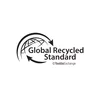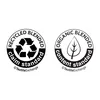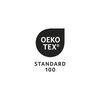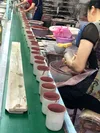CO2 footprint
Energy used to run the facility (heating, cooling, lighting, etc.) and to power the machinery contribute to our / a product’s CO2 footprint. This footprint is included in our annual emissions report! Find it in our Library. Read the mention of our solar panels project above which contributes to lowering our CO2 footprint!
Water usage
Some printing techniques require water to clean or wash items or used machinery.
Chemicals used
Most (if not all) inks include chemicals. Chemicals can be harmful to the environment if they are not disposed of properly. Moreover, applying printing techniques that use a lot of chemicals may be harmful to human health. Ensuring proper personal protective equipment is available and worn at all times by staff is key!
Waste
At Printmasters waste is separated and treated accordingly; where possible waste is recycled. Another important aspect is separating waste by ‘regular’ and waste that is classified as a ‘dangerous good’. As part of their ISO 14001 certification, Printmasters has annual reduction targets for this type of waste.
Labour conditions
Occupational health and safety is monitored through ISO 45001 certification. To be extra vigilant and maintain best practice, Printmasters is also audited according to Sedex SMETA framework once a year. Already mentioned are the chemicals to which workers may be exposed, but monitoring noise levels and air quality (dust or particles from inks) is also important.













